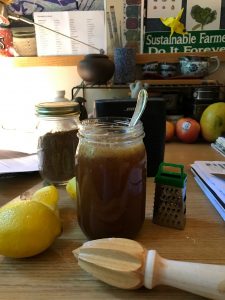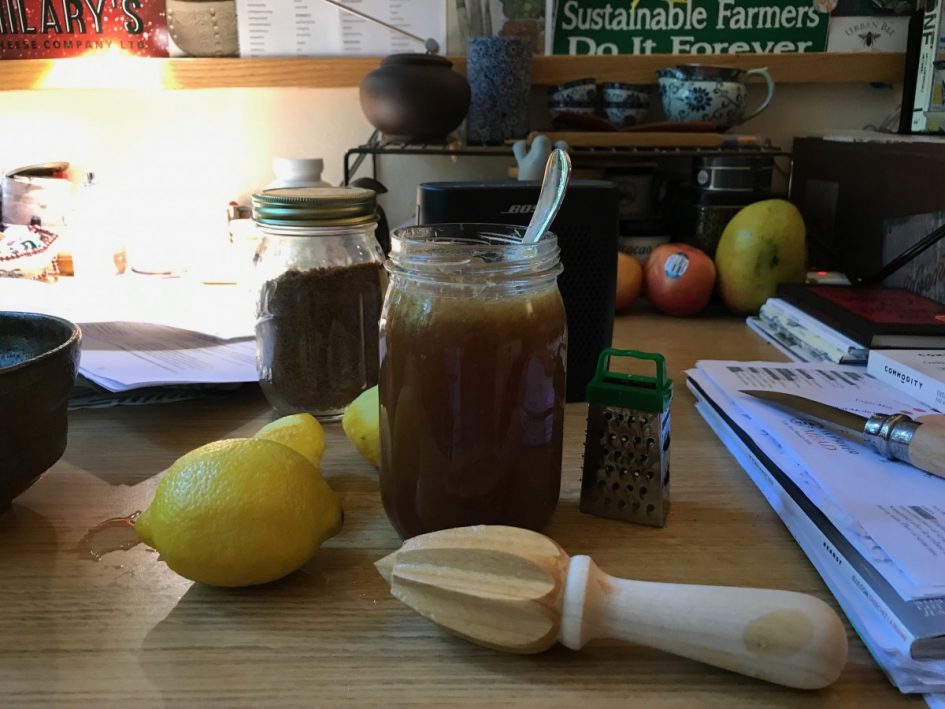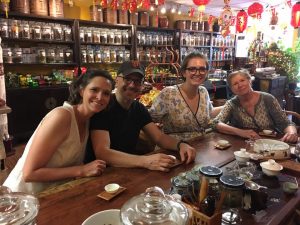Do you think you might be coming down with a touch of plague? Try lemonade!

Sorry about the off-putting brown color; I used coconut sugar instead of white sugar, which gave it a certain swamp-y quality…
This week, I went on many food explorations, but perhaps the most surprising was the drink that may have prevented the second wave of the plague in 1688 from such a devastating effect in France – lemonade. According to the book Food Fights & Culture Wars: A Secret History of Taste by Tom Nealon, there are several drinks and tonics to which prevention of the plague is attributed, but lemonade may be the most familiar.
Apparently, “Its citric acid helped to prevent bacterial growth in drinking water, meaning that lemonade drinkers were marginally more likely to survive.” Many similar drinks gained popularity in and following that era: hot water with lemon slices, eaux de vie, hypocras, and orgeat.
The plague era recipe for lemonade, or aigre de cedre, a “pulpier compatriot” of the modern drink calls for “a mixture of lemon juice, pulp, zest, sugar, and water.” I made it, and it’s not too bad! Certainly beats the bubonic plague.
At the time, lemonade wasn’t necessarily recognized as the great barrier between plague bacteria and the body. In fact, vinegar “took pride of place as the most effective plague repellent.” Doctors would often attend plague victims with vinegar-filled masks, and many used vinegar topically around the nose and mouth to prevent inhalation of the disease.
In reality, though vinegar would have been useful in killing the bacteria in person-to-person contact, it was the lemonade that was more effective against the more frequent carriers of the disease: the fleas. Citrus is a natural insecticide and insect repellent. In putting the unused pieces of lemon used in beverages into the trash, the limonene (the active insect killer in the citrus) went where it was needed the most, coming into contact with the rats and killing their plague-bearing fleas.
So did lemonade save Paris? It would seem so. But either way, I’ll keep drinking aigre de cedre. It tastes pretty good!
On another beverage exploration this week, I visited Kotomi’s recommended tea shop in Seattle, the New Century Tea Gallery in the International District. There, my family and I enjoyed cup after cup of Pu Er tea, as well as a bit of Monkey Pick Oolong and a delicious cold-brewed green tea. It was so incredible to finally share the experience and excitement of tea and its ceremony with my family after telling them so much about it. Tea is so important, both socially and historically, and it is a great vector of connection. If you sit and enjoy tea, you are somewhat forced to enjoy the company you’re keeping. It’s a new way to interact with people and appreciate delicious flavors together.


Leave a Reply